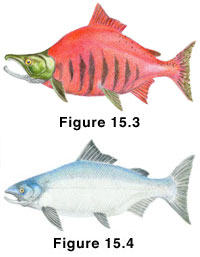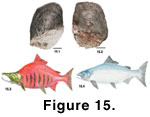 Description
DescriptionOncorhynchus nerka (Sockeye
Salmon)
(Other common names: Red Salmon, Blueback Salmon)
Figures 15.3-15.4
 Description
DescriptionLength: 84 cm.
Mouth: large, terminal, directed forward; upper jaw extends beyond the posterior edge of orbit; snout is blunt; lips fleshy, teeth are in mandibles, premaxillaries, maxillaries, palatines, and the anterior region of the tongue; teeth are small in sea-run individuals; in spawning males, they are large and hooked.
Body: elongate; caudal peduncle moderately compressed; caudal fin forked; adipose fin small and slender; 28-40 rough and close-set gill rakers over the first gill arch.
Color: greenish blue with dark speckling on the dorsal surface; no large dark spots; spawning males have a green head with dark jaws, red body, red fins, and pale ventral surface; spawning females are similar with green and yellow blotches.
Depth: pelagic schooling; 0-250 m.
Habitat: open Pacific offshore waters, coastal streams, and also lakes (some populations landlocked).
Season: in summer, sea-run adults move from continental shelves to coastal spawning rivers in the fall. Incubation can range from 50 days to five months depending on water temperature. Hatched young will remain in the gravel beds of the river for three to five weeks then migrate to a nursery lake where they will usually spend one year (some will migrate directly to the sea).
Diet: freshwater fry eat insects and larvae, copeods, amphipods; young at sea feed on coastal plankton (e.g., copepods); adults feed on other forage species (e.g., herring, sand lance, greenlings, eulachon) and various planktonic crustaceans (e.g., copepods, euphasiids), squid.
Predators: larger fish species including other salmon (on young), sea birds, marine mammals, and terrestrial mammals.
Distribution: southern California to Alaska to the Bering Sea, to Kamchatka, and the Sea of Japan.
 Scale
Description
Scale
DescriptionRelative Size of Scale: moderate.
Position of Scales on Body: in rows above the lateral line canal 118-147; also on the lateral line canal 121-140 (Hart, 1973).
Overall Scale Shape: circular to somewhat oval anterior field, the posterior field is rounded but the edge can be irregular.
Focus and Circuli: focus is clearly defined and often centralized between the fields; often just anterior to the interface of the posterior field. The circuli are concentric with the scale outline. They are generally continuous between the lateral and anterior fields, but there may be a small number of discontinuous circuli. The posterior field is clear and some reticulation pattern may extend into it (but it may be difficult to see).
Radii: absent.
Remarks: Mosher (1969) found that there is a pronounced freshwater nucleus with one or more winter marks; the oceanic region usually has two or three winter marks; there are no more than six complete circuli below the focus; the circuli are not as distinct; the posterior field is clear with no markings (if markings present then they are poorly defined); and in ocean-run sockeye, the posterior field is still clear. Bilton et al. (1964) indicated that there are at least one freshwater annuli, and reticulation at the edge of the posterior edge is ladder-like.